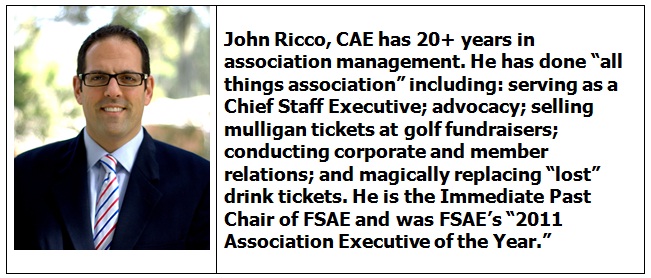By: John Ricco
The non-profit sector is fighting harder than ever for dues, sponsorships and traditional sources of income. Although it would be nice, let’s face it, we all can’t develop the next Ice Bucket Challenge. Many of my association colleagues want to start generating more affinity programs for their organization and often times they are not sure exactly where to start. This post addresses some of the things that should be considered when developing affinity programs and should provide food for thought as you look for opportunities to better serve your members and provide additional financial resources for your organization.
1 – Concept. Do you have a solid product or service you are looking to offer to your members?
2 – Market Analysis. Is there a demand among your members for the product/service? Have you done the research necessary to assure mass appeal and a successful launch?
3 – Competition. What is the competitive landscape? Are there others who offer something similar? How can you differentiate your product? What is your unique selling proposition (USP)? 
4 – Capital Investment. “It takes money to make money,” the saying goes. What type of capital/seed money is needed to develop and launch a program? Do you need outside help to develop the program or evaluate proposals? Is there IT infrastructure that needs to be built out to accommodate the venture? What type of resources do you need effectively market the program? Ideally, set aside a portion of future affinity program revenues to help serve your association’s “R&D” efforts.
5 – Procurement Process. Is this the type of effort that warrants a formal process with multiple proposals/bids or is “sole source” effort sufficient? A competitive process, often times, will ensure your members you conducted the due diligence necessary to ease any concerns they may have.
6 – Profitability. Are the margins wide enough to allow for highly competitive pricing and still provide a revenue stream for your organization?
7 – Legal/Contracts. How many and what types of agreements need to be developed? You may need contracts with vendors, other organizations (if you are collaborating on the venture), consultants, etc.
8 – Risk. Are there any inherent risks or liabilities created for your organization by undertaking the program? What steps can be taken to mitigate the potential liabilities?
9 – Conflicts. Are there any legal impediments or conflicts with other endorsed vendors, major donors, members or business partners of your organization?
10 – Due Diligence. While most of the steps above are part of a due diligence process, do your best to ensure no stone is left unturned. For example, if you are partnering with a private company, once you have narrowed your choice to a vendor or two, you may want to obtain independent data on the finalists via a Dun & Bradstreet or other report. Tools like this will provide information on the creditworthiness, overall financial position and pending litigation on any entity with which you may be partnering. A few hundred dollar investment will pay dividends in the long run.
As promised, short and to the point. I hope these tips help with your revenue generating activity.






